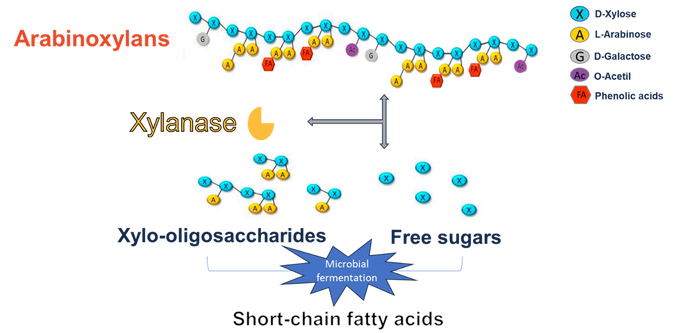Does xylanase impact gestating, lactating sow digestibility?
Research examines if exogenous xylanase increases ATTD, energy during two reproductive cycles.
December 21, 2023
.jpg?width=850&auto=webp&quality=95&format=jpg&disable=upscale)
By Jessica P. Acosta and Hans H. Stein, University of Illinois
Exogenous enzymes produced and isolated from bacteria or fungi, are among the additives that are often included in diets for pigs. Exogenous enzymes may improve the fermentation of dietary fiber in the hindgut of pigs by hydrolyzing complex carbohydrates into oligosaccharides and sugars. In particular, the enzyme xylanase may increase the degradation of arabinoxylans, which are the main polysaccharides of the fiber portion in cereal grains and cereal co-products.
Degradation of arabinoxylans results in release of sugars and oligosaccharides that can be fermented by the microbiota in the hindgut of pigs, resulting in more energy available for the animals (Figure 1). However, there are limited data on the impact of xylanase on energy and fiber digestibility in gestating and lactating sows.
Therefore, an experiment was conducted to test the hypothesis that exogenous xylanase added to diets for gestating and lactating sows will increase the apparent total tract digestibility of gross energy and total dietary fiber and increase concentrations of digestible energy and metabolizable energy during two reproductive cycles.

UIUC. Figure 1. Mechanism of action of xylanase on arabinoxylans hydrolysis.
Two diets for gestating sows and two diets for lactating sows containing corn, soybean meal, distillers dried grains with solubles, wheat middlings and soybean hulls were formulated without or with 16,000 BXU per kg of exogenous xylanase (Econase XT; AB Vista, Marlborough, UK). Lactation diets contained an indigestible marker to determine digestiiblity. Diets were fed to gestating and lactating sows in two reproductive cycles.
Forty-eight sows were randomly allotted to the two gestation diets seven days after breeding in a randomized complete block design with four blocks (24 replicates per treatment, 12 sows per block, six sows per treatment in each block). Sows were placed in metabolism crates on day 35 and day 95 (mid- and late-gestation) for 10 days with feces and urine being collected for five days. All sows were moved to the lactation unit on day 106 and feeding of the lactation diet was initiated.
Fecal samples were collected (grab-sampling) for five days starting on day 10 post-farrowing. Sows were weaned on day 20 and were rebred. Forty-six sows were placed in metabolism crates on day 35 and 95 in the second cycle, and treatments in the farrowing unit were as in the first cycle.
Results indicated that in the first cycle, the ATTD of TDF in late-gestation was greater (P < 0.05) in sows fed the xylanase-diet compared with the control diet (Table 1).
UIUC. Table 1. Apparent total tract digestibility (ATTD) of gross energy and total dietary fiber (TDF), and concentrations of digestible energy (DE) and metabolizable energy (ME) in experimental diets fed to sows during the first reproductive cycle.
During the first lactation period, sows fed the xylanase diet had greater (P < 0.05) ATTD of TDF and gross energy and greater (P < 0.05) DE than sows fed the control diet. During the second gestation period, sows fed the xylanase-diet had greater (P < 0.05) ATTD of gross energy and DE in mid-gestation, and tended to have greater (P < 0.05) DE in late-gestation as well, but no differences were observed for the ATTD of TDF (Table 2). During the second lactation period, sows fed the xylanase-diet had greater (P < 0.05) ATTD of TDF and gross energy and greater (P < 0.05) DE than sows fed the control diet.
UIUC. Table 2. Apparent total tract digestibility (ATTD) of gross energy and total dietary fiber (TDF), and concentrations of digestible energy (DE) and metabolizable energy (ME) in experimental diets fed to sows during the second reproductive cycle.
The greater ATTD of TDF and greater DE in lactation that were observed for sows fed diets containing xylanase indicates that xylanase may enhance the fermentation of arabinoxylans, by releasing xylo-oligosaccharides that are more fermentable and soluble. Xylo-oligosaccharides are sugar oligomers from xylose residues, composed of 2 to 10 monomeric units, which may change the composition of the substrate that hindgut microbiota can access, resulting in a prebiotic effect that promotes the proliferation of commensal microbiota and subsequently increase production of short-chain fatty acids, as well as reducing pathogenic bacteria.
Therefore, xylanase promotes production of short-chain fatty acids, which can be used as a source of energy by sows. Xylanase may also degrade the physical fiber matrix, which releases trapped nutrients, and thus increasing the access of endogenous digestive enzymes to these nutrients.
In conclusion, digestible energy was greater for sows fed diets containing xylanase than for sows fed the control diets during two reproductive cycles, and sows fed lactation diets with xylanase had greater digestibility of fiber, which indicates there is an opportunity to include more fibrous ingredients, such as cereal coproducts in diets for lactating sows with the addition of xylanase. Future research may focus on using exogenous enzymes in combination with xylanase to enhance the fermentation of fiber by gestation and lactation sows.
You May Also Like



